
High Plains Gardening
The gardening website of the Texas High Plains Region
My favorite gardens to visit are gardens that express the owners interest and passion in gardening and horticulture. These gardens reflect the amount of effort and time, not to mention expense, their owner commits to their vision. A great garden is more than just a successful landscaping scheme, although that is certainly important. The extent of the owner-gardener’s investment is reflected in the benefit even a casual visitor can glean from their experience. (Photo at left, view of the Conservatory Complex from the Fountain Terrace; photo at right of the entrance.)
Coupled with the founder-gardener’s personal imprint is a commitment to excellence throughout the grounds and in every facet the institution evolves into over time. Still evident today is Pierre du Pont’s hand in setting the stage, using space, plant and hardscape to create different emotions. Drawing from du Pont’s favored elements of Old World European garden design combined with the free, naturalism that is embodied in the American landscape, the current professionals who manage the gardens keep true to his vision. As I moved through the landscape, the emotions du Pont hope to evoke, was felt. 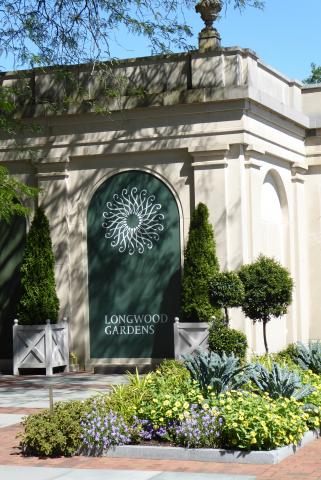
This July, my husband Mark and I toured another of America's premier gardens, Longwood Gardens in Kennett Square, Pennsylvania. Similar to Henry Shaw, the founder and driving force of the Missouri Botanical Gardens, Pierre S. du Pont not only left his mark on Longwood, but indelibly stamped it for decades with his idea of a great America garden and his hope for it to be recognized “as a world apart.”
Longwood Gardens includes over 1075 acres of gardens, fountains, paths through forests, woodlands and meadows, around lakes and grand plazas, and a through a series of glass houses that make up the four and a half acre conservatory complex. Developing a space so large and varied is no easy task for one season; Longwood Gardens displays four seasons of interest in many of the areas.
Longwood Gardens is a huge enterprise with an annual budget of $50 million, and a staff of 1,300 employees, students and volunteers. Over 1,500,000 people visited Longwood in fiscal year 2017, with over 300,000 visiting during Longwood’s Christmas Display, one of the five seasons of Longwood – Orchid Extravaganza, Spring Blooms, Festival of Fountains, Autumn Colors and A Longwood Christmas. Entertainment includes a variety of music, cultural programs, and fountain displays choreographed with music, numerous light displays and fireworks throughout the year.
At the end of the Gilded Age, Pierre du Pont traveled through Europe visiting the gardens of Italy, France and England. Following the Victorian era and in the period of La Belle Epoque, du Pont toured the impressive conservatory at Kew Gardens and the grand English estates, Italian fountains, villas and French chateaus. These trips helped form his vision of gardens, architecture and fountains. He was intrigued by the huge display of water pumps at the 1876 Centennial Exposition in nearby Philadelphia and the illuminated fountains at the 1893 World’s Columbian Exposition in Chicago. (Photo at left of the Octagon Fountains in the Main Fountain Garden.)
Influenced early in early life by nature’s beauty and his family’s history of gardening, he purchased the Peirce estate north of Wilmington, Delaware in 1906, which dated back to the original Penn land grant. In 1700, Joshua Peirce purchased 402 acres from William Penn’s commissioners. Peirce’s Park, as it was known, grew into an arboretum composed of native and exotic specimens. By 1830, it was described as having one of the finest collections of woody plants of any park or arboretum in the United States. Specimens came from John and William Bartram, Humphrey and Moses Marshall and the French explorer, André Michaux. To preserve and prevent one of America's arboretums from being sold for lumber, at the age of 36, Pierre bought the farm and woods and began to create his gardening vision, a place where he could entertain his friends in the grandest European tradition. Named after a stretch of woods known locally as The Long Woods, over time it developed into Longwood Gardens.
Soon after purchasing Peirce’s estate, he set to work on the garden. First to be installed was the 600 foot long Flower Garden Walk (photo at right), followed soon after with the Open Air Theater, influenced by one he saw in Siena, Italy. Du Pont’s theater garden included hidden fountains that would shoot out and surprise his guests. Performances of all kinds are still presented throughout the summer.
For winter entertainment, a conservatory for exotic foliage with a small marble fountain was added to the house. Beginning in 1916, plans for a large, stunning, stand-alone indoors facility was “designed to exploit the sentiments and ideas associated with plants and flowers in a large way.” This main conservatory was completed in 1921. Over the decades, the main conservatory expanded into the multi-room conservatory complex. (This does not include greenhouse production facilities.)
Another main interest of du Pont’s was organ music, particularly large pipe organs. In 1923, an elegant walnut paneled Music Room was built opening onto the central axis of the main greenhouse (conservatory) to house a massive 3,650 pipe Aeolian organ. In 1929, du Pont built the Ballroom for performances and to house the new, even larger 10,010 pipe Aeolian organ. The organ has gone through restorations, the last completed in 2011. The Longwood Organ Academy is one of the components of Longwood’s multi-faceted education programs. As the garden progressed, Du Pont shared the gardens, conservatory and performances not just with his friends, but with the public. Over the years, du Pont hosted nearly 1500 concerts. It soon became the place to visit.
In the decade between 1926 and 1936, du Pont’s interest with water and fountains came into realization. Water features can be found in many of the outside gardens, as well as in the conservatory complex including lakes and streams, to waterfalls, cascades, tropical water gardens and children’s fountains and in many garden areas. Fountains started to pop up everywhere, from the Italian Water Garden to the Main Fountain Garden, the Grotto, Open Air Theatre, Square Fountain, Round Fountain, Sylvan Fountain; a complex of pipes and pumps delighted his family, friends and the public. (Photo at left in the East conservatory.)
Early in the process of designing and building Longwood, Du Pont intended it to become a public space. By 1946, Longwood Gardens officially became a public garden “for the sole use of the public for purposes of exhibition, instruction, education and enjoyment”. The first board’s mission was to “transform a private estate into an internationally recognized horticultural display.”
Over the subsequent decades, more conservatories were built to house various collections, and eventually connected together to form an interlocking glasshouse complex that spans four and a half acres. In the center of the conservatory complex, are five water pools that display temperate and tropical water plants, including the large plattered Victoria water lily, Victoria amazonica, and Victoria ‘Longwood Hybrid’ (V. cruziana x V. amazonica) with its large and stunning flower. Longwood’s water lily collection is accredited to be the largest and finest in the United States.
Besides the water lily collection at Longwood, other core collections include boxwoods, azaleas, camellias, chrysanthemums, orchids, and the trees. Areas in Peirce’s Park, Peirce’s Woods, Hillside Garden and Oak and Conifer Knoll have been heavily interplanted with two million spring blooming bulbs (chionodixa, crocus, muscari and scilla) to augment winter interest and color. In 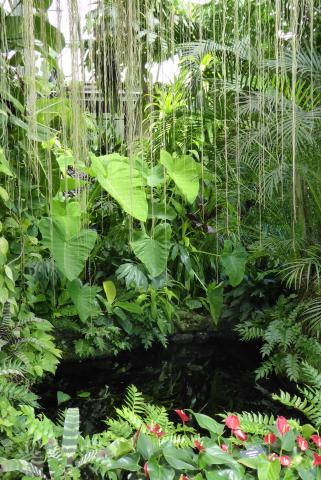 1995, the “concept of using native plants to create a woodland garden as an art form was one of the first such projects in any public garden. (Photo at right is part of the linden tree allee.)
1995, the “concept of using native plants to create a woodland garden as an art form was one of the first such projects in any public garden. (Photo at right is part of the linden tree allee.)
Today, Longwood Gardens is composed of 27 separate outdoor garden areas, 20 gardens inside the conservatory complex and four designated fountain gardens. Longwood can boast more fountains than at any other place in America. It’s specialties are many, the most evident being the fountains, elegant European flair, the extensive conservatory complex, dramatic and varied horticultural displays in an environment that feels comfortably democratic in tone through the five Longwood seasons.
Our visit lasted an entire day, from 10:30 a.m. through the conclusion of a spectacular fountain show set to music and colored lights, the grandest such spectacle in America. And yet a full twelve hours was not enough to explore the many gardens and appreciate and notice everything Longwood has to offer for any one day, let alone through the seasons. I’ve written a brief description of many of the garden areas we visited. With over a thousand acres, we couldn’t walk every path, notice near enough of the details, note as many plant combinations as I would have liked or record for myself all the picture perfect compositions there were. (Photo at left was taken in the Tropical Terrace Garden, Conservatory.)
I hope you won’t find my impressions tedious, only inspiring enough to plan a visit sometime in the future. I drew extensively from Longwood’s website, www.LongwoodGardens.org for many of the details and plants for each of the individual gardens as well as all their programs. (Photo at right was at the start of Flower Garden Drive.)
The scope of the garden’s immensity is evident upon entering the gardens from the Visitor’s Center. From this point are paths to the right, the left or straight ahead, each with significantly diverse gardens, areas and features. Immediately ahead and slightly to the right is a path to an expansive open lawn rimmed with copper beeches, Japanese dogwoods and Paulownia trees called the Cow Lot, as it was once a pasture.
Taking the walk to the right, one is lead down Flower Garden Drive (photo at left), a bald cypress allée of seasonal flower beds with yet more walks branching off to secluded garden rooms. Individual garden rooms focuses on wisterias, roses or peonies. If not walking the Flower Garden Drive, turn left and pass the Rose Arbor and Threatre Garden.
Flower Garden Walk. At the the Open Air Theatre, turn right onto the Flower Garden Walk, the 600 foot brick walk with wide perennial borders on each side with a mix of woody shrubs, grasses, perennials, annuals and bulbs drawing on all the colors of the color wheel. The Flower Garden Walk is also a location of one of Longwood’s dramatic tulip displays in the spring. The Round Fountain (photo at right) is situated midway on the walk. The Round Fountain and Flower Garden Walk were du Pont’s first areas he designed. This double bordered walk is the longest and most colorful display we’ve ever seen. It rivals any mixed border that Great Britain has to offer.
At the end of the Flower Garden Walk are different paths. But here pause at the Whispering Bench and listen. One is far enough away from the sounds and smells of cars, traffic and roads and a quietness is evident. What one does hear are the soft exclamations of fellow visitors, surprising little intakes of breath that speak words of appreciation for what one sees all around. The morning air is cool, crisp an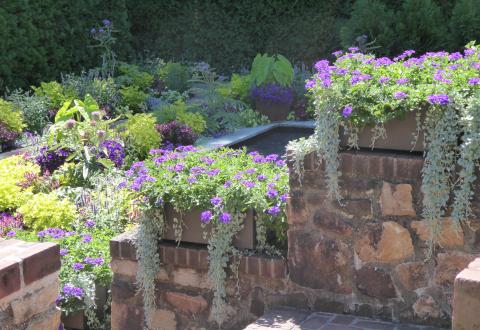 d fresh so far from the city. One can imagine, a hundred years ago, similar reactions from Pierre du Pont’s friends. The women in long, tight fitting layered clothes, holding up a parasol with one hand, the other on her beau’s arm, discreetly commenting how fabulous the combinations of colors and textures excited the imagination and making mental notes to try this at home.
d fresh so far from the city. One can imagine, a hundred years ago, similar reactions from Pierre du Pont’s friends. The women in long, tight fitting layered clothes, holding up a parasol with one hand, the other on her beau’s arm, discreetly commenting how fabulous the combinations of colors and textures excited the imagination and making mental notes to try this at home.
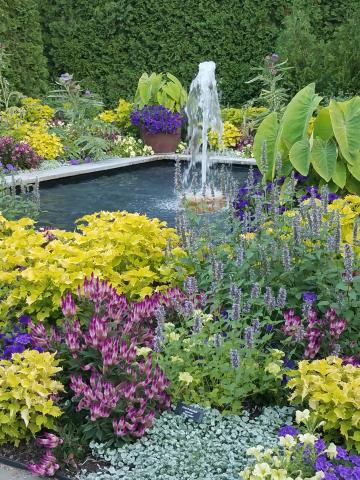 Square Fountain. So which path to take? To see it all, one could do a little doubling back, careful not to miss the secluded Square Fountain and garden. It reminded me of a private shaded neighborhood where a wealthy owner’s backyard garden enjoys a rare square of sunlight revealing a sunken garden fountain and pool surrounded by a riot of color. (Photos at both the left and right of the Square Faountain.)
Square Fountain. So which path to take? To see it all, one could do a little doubling back, careful not to miss the secluded Square Fountain and garden. It reminded me of a private shaded neighborhood where a wealthy owner’s backyard garden enjoys a rare square of sunlight revealing a sunken garden fountain and pool surrounded by a riot of color. (Photos at both the left and right of the Square Faountain.)
Canopy Cathedral. Another path will take you along a wooded area. On this east, or right hand side of Longwood, these woody areas act as spacers or connectors between gardens. Canopy Cathedral, one of three wooden treehouses, this one was inspired by a Norwegian church, complete with reclaimed pews. Designed to allow visitors to stop and listen to wildlife in a serene setting. Remaining on this course will bring you to the far side of the Italian Water Garden.
Peirce’s Woods. A third option at this east end of the garden is to enter Peirce’s Woods, not to be confused with Peirce’s Park or the Forest Walk. Peirce’s Woods is considered an art form garden, composed of native plants with large horizontal swaths of foam flowers (Tiarella) and purple creeping phlox used as groundcovers, in contrast to strong vertical lines of the tree trunks. Interspersed among the shorter under-story flowering redbuds, silverbells (Halesia), pinkshell azalea, Rhododendron vaseyi, and dogwoods are Virginia bluebells, dwarf crested iris, rue-anemone and trilliums in the springtime. The South Wood’s Edge is designed for strong fall and winter interest planted with goldenrods, asters, yellow twigged dogwoods and red-fruited winterberry hollies.
When taking the path that leads straight ahead from the entrance, you will encounter the Open Air Theatre, influenced by the Villa Gori in Italy. Further ahead still is The Terrace, which includes the Beer Garden, for dining, relaxing and entertainment. Branching paths are to the right where one would take you to Peirces Park, another to the opposite side of Peirce’s Woods that leads to the Italian Water Gardens, inspired by the Villa Gamberaia water gardens near Florence, Italy.
Italian Water Gardens. As we neared the Italian Water Gardens (photo at right), we walked across the viewing deck that allowed an overhead view of the garden on one side, and the Large Lake on the other. Continuing around the viewing deck to the side are seating areas to rest and watch the fountains. The Italian Water Gardens’s serenity is captured by the lush green lawns, ornate limestone sculptures, blue tiled pools and linden trees lining the sides. This is a peaceful place to listen to the rush of water tightly framed by the surrounding woods. Every aspect of the Italian Water Gardens was designed by Pierre du Pont himself, calculating that the northernmost pools needed to be built fourteen feet longer than the southernmost pool to appear symmetrical when viewed from the deck. There is no doubt you will feel a decidedly European ambiance. (Photo at left is detail under the viewing deck at the Italian Water Gardens.)
After resting a spell, the path continues through the forest allowing us to take in the stillness and coolness that I remember from my time growing up in the Wisconsin woods. Here, too, is a choice to continue on up to the extensive Forest Walk (still a ways off) or along the perimeter of the eighty six acre Meadow Garden.
Meadow Garden. There are paths around and through the Meadow, offering views of differing meadow habitats and vistas. From the Meadow’s edge, we could see swallowtail butterflies, bumble bees and other pollinators flitting from gayfeather, to wild bergamot, cardinal flowers, joe-pye weed, and milkweed in bloom.
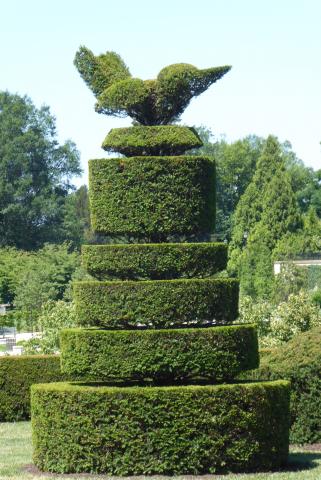 If choosing the longer 3 mile trek around the Meadow Garden, you will eventually come to the historic Webb Farmhouse and Galleries, with yet more paths to circle back around without repeating. Eventually you will make your way pass the hourglass Lake and past the Birdhouse or Lookout Loft Treehouse near the Peirce-du Pont House. One way leads to the Forest Walk that enables one to experience what Penn’s sylvan country was like centuries earlier. Regrettably, we elected not to traverse the expanses of meadow and woods, but to leave some areas to explore anew during a return trip, however pleasant and interesting the appeal at the time. To walk the complete grounds of Longwood in one day requires less travel-weary legs as mine. But as we skirted the edge of the meadow and woods, we inhaled deeply of the clear country air, listened to the hum of bees and song play of the birds.
If choosing the longer 3 mile trek around the Meadow Garden, you will eventually come to the historic Webb Farmhouse and Galleries, with yet more paths to circle back around without repeating. Eventually you will make your way pass the hourglass Lake and past the Birdhouse or Lookout Loft Treehouse near the Peirce-du Pont House. One way leads to the Forest Walk that enables one to experience what Penn’s sylvan country was like centuries earlier. Regrettably, we elected not to traverse the expanses of meadow and woods, but to leave some areas to explore anew during a return trip, however pleasant and interesting the appeal at the time. To walk the complete grounds of Longwood in one day requires less travel-weary legs as mine. But as we skirted the edge of the meadow and woods, we inhaled deeply of the clear country air, listened to the hum of bees and song play of the birds.
Peirce-du Pont House. The Peirce-du pont House was the home of the Peirce’s dating back to 1730, and then enlarged for Pierre du Pont and his wife, Alice, to live. We took some time to go inside to tour and explore the historical exhibit. Pierre married his cousin, Alice Belin, in 1915 when he was 45, she two years younger, shortly after the death of his mother. They had known each other their entire life. Alice accompanied Pierre on tours to Europe in 1910 and 1913, sharing his passions and interest in gardening. The couple never had children. The home includes du Pont’s first conservatory that housed his ‘winter garden’ who’s success inspired him to build the conservatory complex. Despite additions to the house, it is relatively small compared to most estate homes of the era. After the death of Alice in 1944, Pierre lived mostly at their home in Wilmington, Delaware.
The third route to take in exploring the many and varied aspects of Longwood offers a choice – whether to take a hard left, or to walk straight up the allee on the left side of the Cow Lot. We took the allée to the main fountain area. To our left is the Rose Garden, followed by the Topiary Garden (photo at right), with 45 quite large topiary yews. To the left of that is the Carpinus Allée, tightly pruned hedges of European hornbeam, yew, catmint and my favorite, blackberry lily (Iris domestica).
Main Fountain Area. At the end of the walk, turn left and face the extravagant Main Fountain area (photo at left) some have termed the American Versailles, one of the focal points of Longwood. The Main Fountain area just received a $90 million makeover, reopening in May, 2017. This makeover included re-imagined space that is both inviting and awe-inspiring. Jaw-dropping, really. There is seating above and below to vie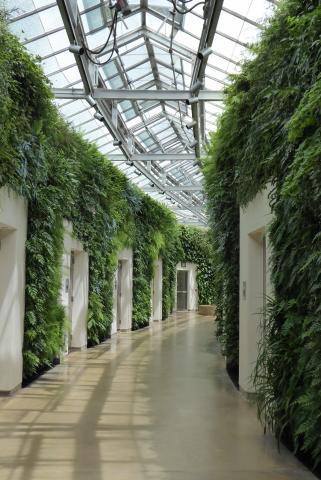 w 15 minute fountain shows every two hours to custom-choreographed to music, that varies with each performance. The thirty minute evening show was spectacular! The program doesn’t begin until the sun is well set and the stars are twinkling in the sky. Situated out in the country, there is little light pollution from cities.
w 15 minute fountain shows every two hours to custom-choreographed to music, that varies with each performance. The thirty minute evening show was spectacular! The program doesn’t begin until the sun is well set and the stars are twinkling in the sky. Situated out in the country, there is little light pollution from cities.
The Upper Canal features 29 octagons outlined by boxwood. The fountains create basketweave patterns and at night during the fountain/light show, displays fountains of fire, a truly unique sight. The Main Fountain area includes 2,600 boxwood (Buxus microphylla var. japonica ‘Green Beauty’). These provide contrasts in shape and textures to the three broad French Villandry inspired allées of littleleaf lindens that frame the Main Fountain Garden. Walking, rolling and relaxing on the grass between the boxwood and sidewalks is encouraged.
Other features include the Grotto, Italian limestone Pumphouse Facade, Turtle Pond, Fountain Terrace and Rectangular Basin, the site of the show fountains and LED lighting. Take time to thoroughly explore the entire Main Fountain Garden, the detail is worth noting.
We headed on up to the four and a half acre Conservatory complex, the other main focal point of Longwood and entered through the East Conservatory (photo at left). Standing at the entrance, the view was extraordinary! In the foreground is a pool with two fountains ringed with a display of pink flowering curcuma (member of the ginger family), with views of another pool in the distance. To the left is a lawn. The plant list is extensive (plant lists of the individual gardens available by clicking on individual gardens and the Plant Explorer tab at the bottom of each page.) This half acre indoor garden includes both permanent collections and seasonal displays, centered by central water features of waterfalls, pools and fountains. I took a nearby seat to listen to the water flowing from one of the cascades and take in the flowers and foliage around me.
Green Wall. We visited the conservatory immediately after lunch at the Terrace area. So, soon after, we looked for a lavatory. Just off the East Conservatory is the Green Wall (photo at upper right), probably the most unique feature at Longwood. It is the largest green wall in North America at 300 feet long by 14 feet high, filled with 47,000 plants. The plants along the wall frame rooms, some of them service rooms, but most of them are lavatories, clean, small private spaces for individuals and parents with children requiring attention. The plants help clean and oxygenate the hallway in this bright conservatory space.
Back into the East Conservatory, following the walk leads to, on the right, the Ballroom and Aeolian Organ, the site of many performances then and now.
Exhibition Hall. Next, we walked into Exhibition Hall (photo at right), where horticultural exhibits and even more performances take place. It’s sunken marble Fern Floor is usually filled with a few inches of water, but can be drained for performances. It’s surrounded by mature tropical displays of tree ferns and hanging baskets overhead. I’ve never been to Costa Rica, or any other tropical area, but standing in Exhibition Hall, I’m sure, was a much more comfortable experience here. Removed from the tropical experience are biting insects and snakes dropping from trees to cause fright. The air had the fragrance of sweet flowers and the earthy smell from all the leaves in this warm, humid and sunny space, but not enough to make one sweat.
Waterlily Garden. From Exhibition Hall, we stepped outside to explore the outdoor Waterlily Garden (photo at left). The Waterlily Garden is the first of three gardens I viewed as exceptional (totally subjective assessment) and were my favorite of the gardens. Choosing three, upon reflection, is quite difficult given the excellence of all the gardens. The ability of a garden to evoking emotions was one of du Pont’s goals. The Main Fountain Garden and Italian Fountain Gardens definitely had the “wow” factor, the Waterlily Garden and two others are more plant based.
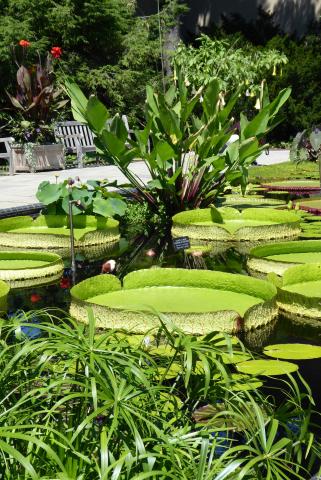
Consisting of five pools, over 100 types of day and night blooming hardy and tropical waterlilies mesmerized me. Water lily flowers in white, yellows, peach, roses, reds, blues, and purple from tiny to large. The lily pads were just as varied. Occasionally, the gardeners would flip a leaf for visitors to view the pad’s intricate underside. Surrounding and intermingled are many varieties of water cannas, elephant ears, lotus, aquatic grasses, reeds and sedges, papyrus, water iris, and others. The Waterlily Gardens contain three types of the giant water platters, Victoria cruziana, V. amazonica and their hybrid, V. x ‘Longwood Hybrid’, developed by Longwood in 1960. I went back in the evening just before the light show to see the night bloomers, so as not to miss out. (Photo of one of the three Victoria waterlily platters.)
Palm House, Bonsai, Estate Fruit House, Fern Passage. A door led up back inside the Conservatory complex into the Palm House. The walkway is elevated above the plants where we were able to view a large collection of palms, cycads and understory plantings from around the world. A connecting corridor houses a Bonsai Display. Leading the way into the Estate Fruit House, that provided nectarines, grapes, citrus, tomatoes, and figs to the du Ponts. This summer it contained trained and pruned nectarines trees and grapes hanging from the ceiling. Another passage displays Longwood’s fern collection, described as both familiar and exotic, is displayed in a long green passage, an extremely diverse fern garden (photo at lower left). Since I live in the Texas Panhandle’s hot dry climate, the majority were exotic to me.
Cascade Garden. Following this cool, long, ferny isle we were immediately transported to an opposite climate in the Cascade Garden (photo at lower right), which showcases tropical South American plants, many of them bromeliads and philodendrons, most of them plants I had neither seen nor heard of before. They are artfully composed around walls of cascading water as you wind around this”S” shaped richly textured garden. It’s designed to give the impression of walking under tropical cascades or waterfalls on mountainsides, without actually doing so. Nicely done.
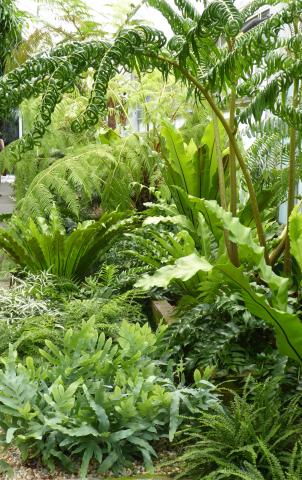 Rose House. The Rose House is the next garden we walked through, but at this time of year, instead of roses blooming, it was filled with flowering Chinese hibiscus plants, that require warm temperatures and bright light. Allamanda, bougainvillea and flame vine add height to the view.
Rose House. The Rose House is the next garden we walked through, but at this time of year, instead of roses blooming, it was filled with flowering Chinese hibiscus plants, that require warm temperatures and bright light. Allamanda, bougainvillea and flame vine add height to the view.
Tropical Passage and Orchid House. Our route brought us into another equatorial environment, the Tropical Passage. Lush and appealing. Ahead to our right was the Banana House, to the left, the Orchid House. The Orchid House is amazing! Orchids are displayed only at their peak of perfection, displaying 200 – 300 from their collection of 6,200. Volunteers renew the display three times a week!-- from their five orchid growing houses! Both Mr. and Mrs. du Pont were charter members of the American Orchid Society. Recall the mention that one of Longwood’s “seasons” is the Orchard Extravaganza from roughly mid January to mid March.
I struggled to leave the world of orchids, but leave I must.
Silver Garden. And gladly so as we entered the warm and dry climate of the Mediterranean in the Silver Garden, dedicated to plants whose foliage are gray-green, blue-gray, gray, white or silver. The Silver Garden is the second of three gardens at Longwood that I think have the most sophisticated displays that rise above the others. Agaves, aloes, bromeliads, senecios, succulents, yucca, cactus and supporting plants from around in the world in the spectrum of gray are astutely arranged among rocks and boulders. The instant attention grabber is a flawless stream of Dichondra argentea ‘Silver Falls’ that trails over the rocks out onto our walkway. Next to the Dichondra are mass plantings of Dyckia ‘Silver Superstar’ and ‘Nickel Silver’. Many of the plants are in mass groupings. To add height, tree size ponytail and big blue Hesper palms, the giant Cephalocereus, Pachycereus and Stenocereus cactus from Mexico, and Pachypodium from Madagascar are growing. Baskets of rose flowering Pseudorhipsalis ramulosa hangs down from the ceiling along with streams of blue vanda orchards. A mature planting, that is, the designers are quite accomplished in their knowledge of plants and the art of display. (Photo of Silver Garden showing the flowing river of Dichondra at lower left.)
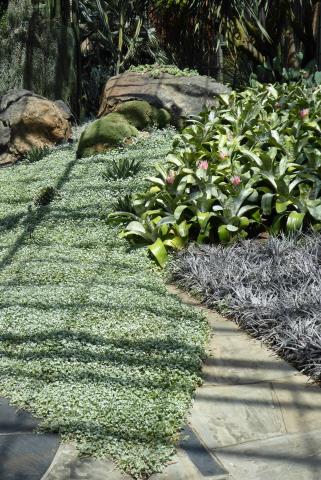 Acacia Passage. The Acacia Passage is narrow and runs parallel to the Silver Garden, so we doubled back to walk through it. Cinnamon wattle, Acacia leprosa, line the sides of the passage; its branches arch over the walkway, covered with fragrant yellow flower clusters. As in all the planting beds at Longwood, the understory is completely planted; here with the liberal use of English ivy. Caladium pots are spaced at six feet intervals. Lush hydrangea baskets with asparagus fern filler are suspended from the ceiling. Heavenly.
Acacia Passage. The Acacia Passage is narrow and runs parallel to the Silver Garden, so we doubled back to walk through it. Cinnamon wattle, Acacia leprosa, line the sides of the passage; its branches arch over the walkway, covered with fragrant yellow flower clusters. As in all the planting beds at Longwood, the understory is completely planted; here with the liberal use of English ivy. Caladium pots are spaced at six feet intervals. Lush hydrangea baskets with asparagus fern filler are suspended from the ceiling. Heavenly.
Orangery. From the narrow Acacia Passage, the conservatory expands into the Orangery, one of the main greenhouse buildings with highly composed color and plant combinations, many of them tropical and subtropical. The display are changed out according to one of Longwood’s five seasons. The design scheme is 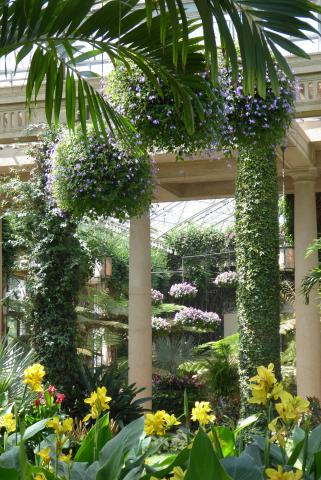 of intricate bed plantings, taller perennials, small trees or palms and lush hanging baskets all in prime condition. Looking off to my left passed the pillars covered with Ficus pumila (a fig vine), the hanging baskets gives greater depth of meaning to the term “hanging baskets” – so large and exuberant. (Photo at right with pillars covered in fig vine, also showing some of the many hanging baskets.)
of intricate bed plantings, taller perennials, small trees or palms and lush hanging baskets all in prime condition. Looking off to my left passed the pillars covered with Ficus pumila (a fig vine), the hanging baskets gives greater depth of meaning to the term “hanging baskets” – so large and exuberant. (Photo at right with pillars covered in fig vine, also showing some of the many hanging baskets.)
Garden Path and Indoor Children’s Garden. We wandered around and meandered through the Garden Path and Indoor Children’s Garden, a delight for adults too. The Indoor Children’s Garden is filled with fountains, pools and spouts and a long slithering dragon in one area. There was so much plant diversity, to name even one does injustice to the others. Mind boggling.
Camellia Garden. The last garden was the Camellia Garden, though not the least. Long past the the time of camellia’s bloom, the beds were thoroughly planted with yellow and white blooming plants. The sweet perfume of jasmine waft down and swirled around my head. I stopped and sniffed again. So reluctant to move on.
We have left the conservatory complex and turn to the left, walking the length of the main fountain overlook area again. The gardens on this west side are divided by trees and boxwood hedges with expanses of lawn that taper off to the woods, offering visual relief from the busyness of the gardens.
Student Exhibition Garden. The first garden we encounter is the Student Exhibition Garden, an area with four quadrants divided by boxwood hedges for four student teams to practice their design skills. It reminded me of some of the smaller show gardens in Great Britain at the RHS Chelsea, Hampton Court and Tatton Park Flower Shows. I award them a silver gilt each.
Idea and Trial Gardens. The Idea Garden and Trial Garden lies adjacent. This is a large area filled with beds divided by grass paths and benches to rest and reflect (we did). Part is devoted to vegetables along with a large trial of dahlias to determine which are most suited to the Pennsylvania area. A giant flower structure is more practical than ornamental – it’s petals are solar panels. The Idea Garden contains a brilliant spring display of tulips, and stunning perennials in the summer and fall to inspire gardeners to emulate. (Photo at left is from the Idea Garden, one view of a large and varied garden.)
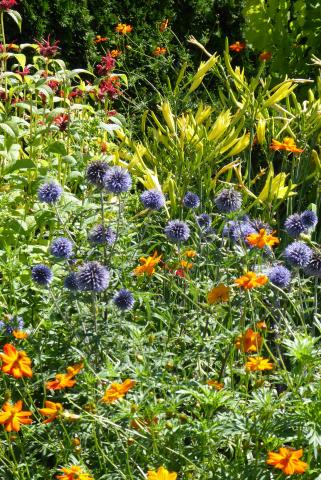 Children’s Garden. The Children’s Garden contains a child-sized flower fountain, built low so even toddlers can splash their hands and the parents look on from the circle of benches. In the fall mounds of pumpkins, squash, gourds and hay bales decorate the area.
Children’s Garden. The Children’s Garden contains a child-sized flower fountain, built low so even toddlers can splash their hands and the parents look on from the circle of benches. In the fall mounds of pumpkins, squash, gourds and hay bales decorate the area.
Fountain Terrace. We walked south along the western linden tree allée of the Main Fountain Garden, to the Pumphouse Plaza for a snack and tour the top Fountain Terrace and pool that houses the fountain jets and LED lights for the main fountain shows. Out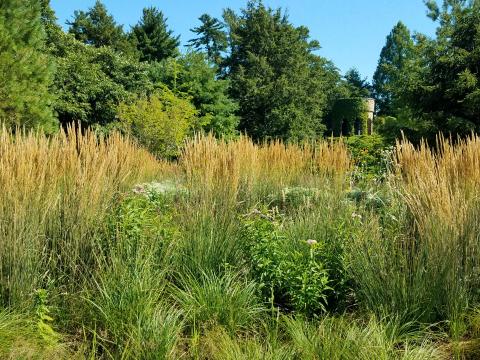 side of these main shows, the fountains spray in an array of patterns throughout the day. It was mid afternoon and warm, so I passed through the mist until cooled by the spray.
side of these main shows, the fountains spray in an array of patterns throughout the day. It was mid afternoon and warm, so I passed through the mist until cooled by the spray.
Hillside Garden, Chimes Tower. Daylilies amassed on the hillside drew our attention. We took the path that lead up the Hillside Garden to the Chimes Tower, Eye of Water and Oak and Conifer Knoll. I loved the Hillside Garden, a garden with four true seasons of interest and one of the most, if not the most, extensive plant list. This garden is the third of my three favorite gardens, as we toured. It is designed with a light and deft hand. At the beginning of the walk are bands of orange daylilies, and a small, sunny, faux meadow area (in contrast to the large 86 acre Meadow Garden at the opposite end of Longwood). To design a small meadow is no easy task; the trick is in getting the right blend, height and mix grass and forbs for a limited space. Which they have brilliantly done. Further up the path is more shaded, filled with hostas in bloom in July, but in spring boasts an array of spring blooming shrubs. Late winter offers an intimate walk through drifts of snowdrops, crocus, Siberian squill, Chionodoxa and dimuative ‘tete-a-tete’ daffodils, followed by masses of varieties and cultivars of Hellebores, and delicate looking Adonis and spring snowflake (Leucojum), cyclamen, trillium, and epimediums cover the forest floor. In fall, the Hillside Garden glows with warm hues of amber, buff and vermillion. (Photo at right of the meadow planting and chimes Tower in the distance.)
Chimes Tower. At the top is Chimes Tower, built from stone unearthed during the construction of the original Main Fountain Garden. The tower houses a 62-cast-bell carillon. Access to and into the tower is from above and below. A waterfall cascades beside it.
Oak and Conifer Knoll. Still at the top, we connected with the trail that leads through the Oak and Conifer Knoll. This is another cool and shaded garden with open sunny areas that feature nine species of oaks and four species of holly. In Celtic tradition, while the oak trees bear leaves, the Oak King rules the world, but once their leaves drop by winter solstice, the Holly King rules the waning year. Four giant sequoia, and two conifer dawn redwoods, incense and Atlas cedar, Japanese flowering cherries, European hornbeam, maples, American and copper beech, camellia and native flowering dogwoods are a few species that are home in this garden. Spring plantings of 500,000 Scilla, Siberian iris, crocus and winter aconite inhabit the sunny knolls that connect with the Hillside Gardens. (Photo at left, one of the many quiet places to rest and contemplate the gardens.)
This sweeping trail lead us back to the starting point at the front of the gardens and the Visitor Center.
Education at Longwood was very important to Pierre du Pont. His desire was to establish a school where students and others may receive both horticulture and floriculture instruction. Longwood distinguishes itself by offering a wide range of classes for people age 5 and up.
Longwood’s numerous adult and children’s education programs includes a fellows program, internships, specialty training, professional development, cooperative education, field trips, scout programs, summer camps, and continuing education. Classes are for children K-12, teens, college students and adults, both professional and for the home gardener. Tied in with classes and hands on instruction is the Student Exhibition Garden where teams of interns create seasonal gardens. (Photo at right is one of the student gardens.)
Another educational outreach is the Idea and Trial Gardens, that feature regionally suitable innovative plant compositions using a plethora of colors, textures, planting designs, growing techniques, cultural methods and plant trials for the public to learn from.
Additionally, conferences and symposiums are scheduled each year. Plant exploration has been carried out dating back to 1798 when Samuel and Joshua Peirce began their arboretum. Since 1950, Longwood Gardens has participated in over 60 plant exploration trips, in the field or by exploring cultivated species from nurseries abroad, through international seed distributions, specialty plant societies and other public gardens. More than 130 new cultivars have been named and distributed by Longwood.
The staff at Longwood grow about seventy-five percent of their display plants, about 110,000 plants that represent more than a thousand varieties.
Pierre du Pont searched for new and innovative methods and techniques, not just in horticulture, but in the operations end of staging a great garden. Whether it’s new pumps for the fountains, newer and better Aeolian organs, greenhouse engineering, or solar energy, Longwood Gardens aims to be in the forefront. In 2011, Longwood launched a solar energy initiative by establishing a 10 acre solar panel field, underplanted with lower growing meadow plants. The solar field furnishes 30 percent of Longwood’s energy needs.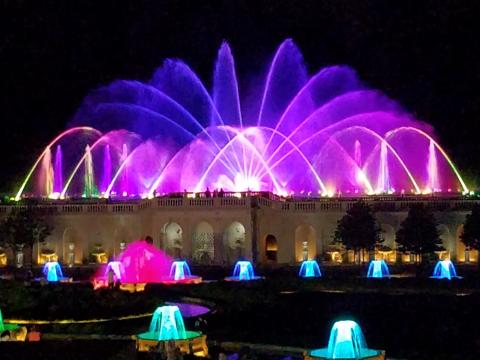
Longwood Gardens has a rigorous composting program and practices Integrated Pest Management thoughout the gardens, with only the minimal use of pesticides. Food from the Trial and Idea Gardens is prepared and served in their Terrace restaurants.
Pierre du Pont’s vision of horticultural excellence, education, and enjoyment of the arts in this inspiring setting, in my opinion, has been accomplished. They have achieved garden perfection. Longwood Gardens has indeed succeed in becoming “a world apart” and great garden not just of America, but the world, and I might add, for all seasons.
Personal visit, July, 2018
Information from throughout Longwood Garden's extensive website, www.LongwoodGardens.org.
Longwood garden's Blog for the past 10 years is posted and contains detailed information about many of the gardens and programs.
Angie Hanna, September 1, 2018